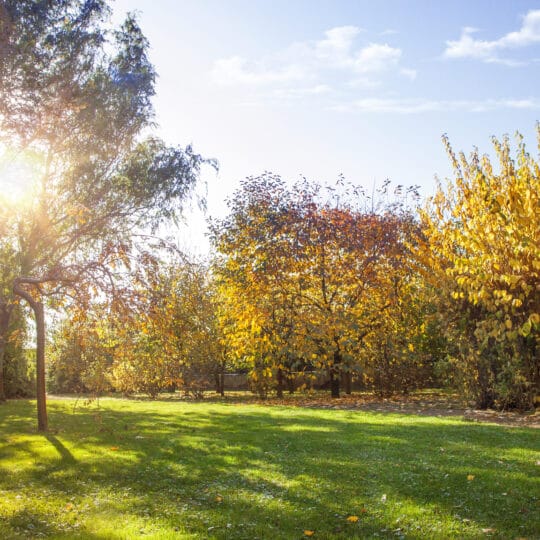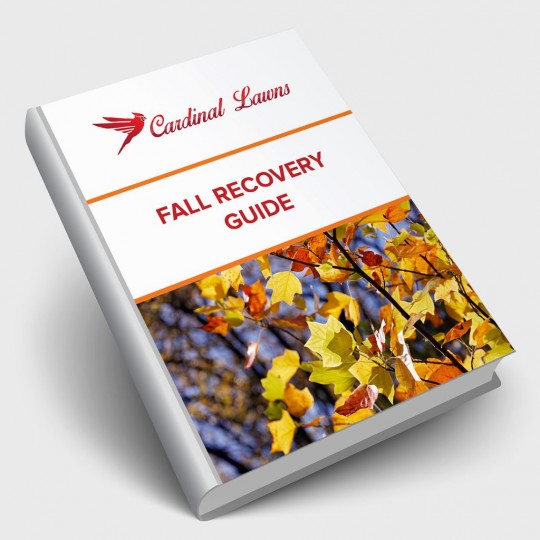Fall Lawn Care Tips
By Grass Type
Posted
September 22, 2022

All summer long, your lawn has taken a beating. From hot temps and little water to foot traffic and wandering wildlife, a lot was going on out there. Now it’s time to reward your lawn for making it through the harsh season with some revitalizing fall lawn care tips.
Determining Grass Type
Before we jump into the lawn maintenance checklist, just a reminder that all lawns are not the same. The type of grass you’re growing determines what tips to follow. There’s cool-season grass, such as Kentucky bluegrass, ryegrass, and fescues. And there’s warm-season grass, including Bermuda, centipede, zoysia, and Bahia grass. If you’re unsure which type you have, a local landscaping company can help you determine.
You may be able to tell which type you have simply by looking at how your grass is growing. For instance, cool-season grass usually goes dormant in the heat. As temperatures drop in early fall, they bounce back and peak in growth. The warm days and cooler nights are the ideal time for strengthening your lawn and establishing new cool-season grass.
Cooler temperatures trigger dormancy in warm-season grasses. If your grass was still actively growing throughout the summer, it was probably a warm-season variety. Even though all grass goes dormant once hit by frost, this type of grass starts slowing down a lot faster, therefore maintenance is a little different.
No matter what type of grass you have, the one thing every lawn benefits from is rich soil. Test your soil this time of year to help determine its current pH level. Adjust your fertilizer accordingly. Doing this step now helps prepare any lawn for spring when all grasses wake up from winter.
You also want to keep on top of the leaves that fall on any lawn. Rake them up or break them up with your mower, but don’t allow a blanket to cover and suffocate your warm or cool-season grass.
Fall Lawn Care Tips – Cool-Season Lawns
Since cool-season grasses bounce back in the cooler weather, they need a little more attention to continue to thrive.
Fertilizing. Estimate about six weeks out before the first expected frost and use a high-nitrogen fertilizer to strengthen roots and reserve energy to survive winter.
Seeding. Any thinning areas or bare spots should be overseeded or reseeded with another cool-season grass. While you may not get months of growth out of it, you will enjoy stronger grass come spring. Help these seeds become established by giving them at least 45 days before the first frost.
Remove thick thatch. While a thin layer of organic matter between the soil and grass can help your lawn, any buildup over half an inch thick limits the amount of water and nutrients that can reach the roots. It also attracts pests and diseases. Break up and rake up the buildup to let your lawn breathe.
Aerate. You also want your soil to breathe. Any compacted areas restrict root development. Aerators remove small plugs or cores from the surface to create channels for air, water, and nutrients to flow.
Watering. Since cool-season grass is still actively growing it still needs water. It doesn’t need as much as it did over the summer, but you still want to estimate about an inch of water per week. Hopefully, more regular rainfall will help keep your water bills low.
Mowing. Since the grass is growing, you want to keep mowing. Consider lowering the blades a little to keep the grass shorter and limit the chance of winter disease.
Weeds. Yup, they’re still growing too. The good news is there are weed and feed products to help you battle what you don’t want and grow what you do. These products work better on established lawns and not newly seeded areas.
Fall Lawn Care Tips – Warm-Season Lawns
This list is a little shorter since warm-season grasses go dormant faster than their counterparts. There are still maintenance tasks to focus on, but other things you don’t have to do.
Stop fertilizing. Feeding warm-season grass later in the season interferes with its need to go dormant. This could leave it open for more winter diseases. Your last lawn feeding should be about eight weeks before the first frost.
Wait to aerate. Dethatching and aerating are still good for warm-season grasses, but better in the spring when it’s actively growing and can bounce back.
Overseed. If your warm grasses are browning, overseed with a cool-season grass, like ryegrass, that stays greener longer.
Rely on rainfall. If you overseed, continue a regular watering schedule. But once your grass goes dormant you can let the rain do all the work.
Weeding. Once the grass goes dormant, cool-season weeds are more than happy to turn your lawn green again. Spot treat these areas with a post-emergent herbicide to help keep your lawn pristine.
Professional Lawn Care
As you can see, fall is one of the more active seasons for lawn maintenance. Not only are you trying to repair your lawn from the harsh summer, but you also want to prep it for the harsh winter. One of the easiest ways to do this is by contacting Cardinal Lawns to help. Whether you have cool- or warm-season grass, our lawn care specialists can put together the right maintenance plan for this season and beyond.

Download Your FREE Fall Recovery Guide
Summer’s extreme conditions can take a toll on your grass and its health. Take some time to learn how to bring your lawn back to life. This handy guide teaches you what needs to be done for a full fall recovery.